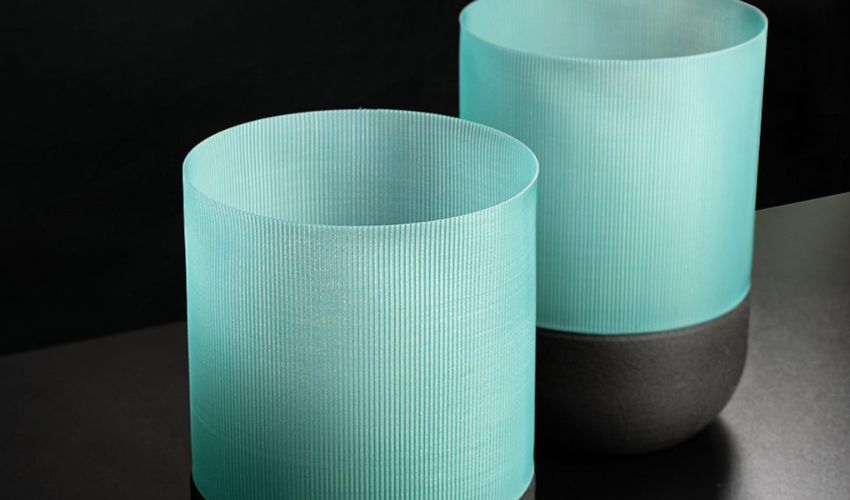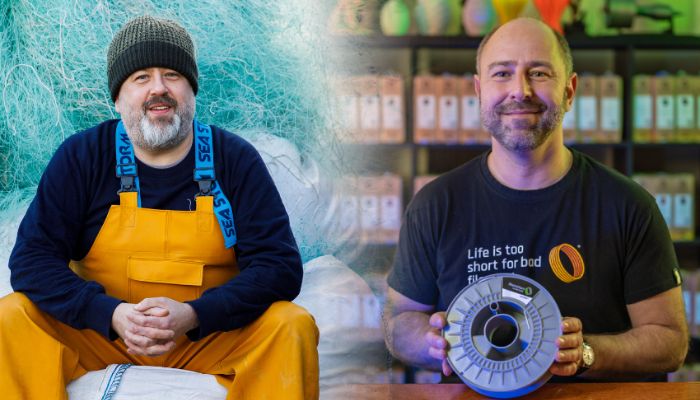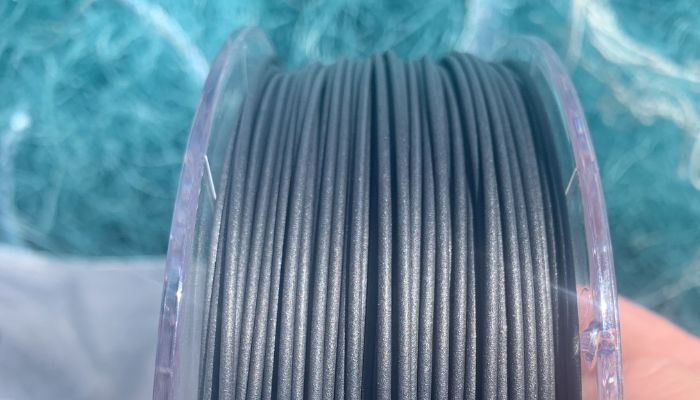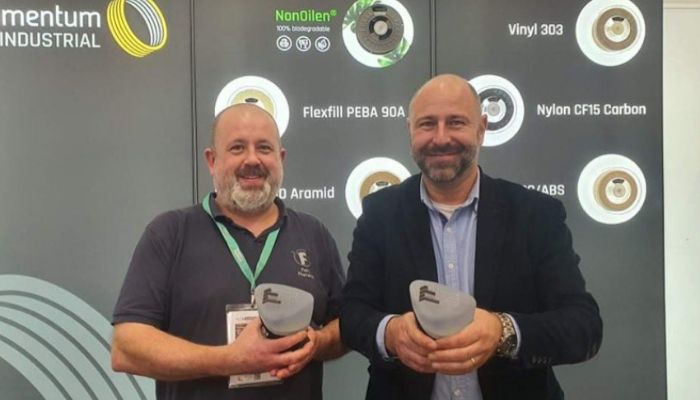
With the world constantly warming and specialists expressing worry that we could not meet the objectives outlined within the Paris Agreements, sustainability is the subject of the hour in nearly each business. Additive manufacturing is definitely no exception. Although 3D printing typically is touted as extra environmentally pleasant, the quantity of plastic that’s used has typically put that into query. Because of this, we’re more and more seeing a drive to develop extra eco-friendly supplies. That is the case with Cornish startup Fishy Filaments. They’re attacking two environmental considerations directly by recycling polluting fishing nets into nylon filaments, working as properly with main materials producer Fillamentum which can be recognized for its sustainable efforts. We spoke with Ian Falconer, the founding father of Fishy Filaments, and Josef Doleček, the CEO and founding father of Fillamentum, to be taught extra concerning the firms, the significance of sustainable 3D printing supplies and their collaboration.
3DN: Might you introduce your self and your connection to 3D printing?
IF: My identify is Ian Falconer. I’m the founding father of Fishy Filaments. My tutorial background is in mining and mineral processing, so supplies slightly than 3D printing as a producing know-how. However I even have round a decade of expertise as an engineer in world telecoms infrastructure. Fishy Filaments is synthesis of these two worlds; taking concepts and applied sciences from each and delivering a brand new take a look at offering excessive efficiency supplies and not using a world provide chain.

Ian Falconer (left) and Josef Doleček (proper)
JD: My identify is Josef Doleček, since 2008 I’ve been working within the subject of plastics processing, first as an worker in a plastics firm. In 2011, I based an organization for precision extrusion of plastics for the automotive business. After I first turned acquainted with 3D printing, I instantly felt that I might convey my expertise in processing polymer supplies to this subject. And this can be a purpose I’ve been making an attempt to satisfy for the reason that very starting of our 3D printing supplies enterprise by way of our 3D printing filament model Fillamentum.
3DN: How did the concept to develop Fishy Filaments come about?
IF: I used to be working within the mine finance sector for an organization who needed to develop a really massive metals mine and so they requested me to take a multi-decadal take a look at their markets. They have been mining titanium, vanadium and had a by-product of excessive purity iron ore – all as powders. I noticed some highway blocks in that world in the event that they have been to serve Additive Manufacturing at a sustainable worth and determined to try to deal with them.
For numerous causes I didn’t get to the purpose of supply with these options throughout the metals world however discovered that they labored simply as properly, and doubtless higher, on the earth of polymer recycling. Fishy Filaments embodies a technological resolution that was on the lookout for an issue and located it in end-of-life fishing gear.
3DN: What’s the significance of recycling fishing nets into filaments?
IF: Whereas the answer was fairly undoubtedly engineering and science led, the issue of fishing gear administration and disposal may be very nuanced and complicated, however globally necessary. The actual kind of nets we goal, constructed from nylon monofilaments, are chargeable for round 20% of the worldwide fishing catch by tonnage and by worth. They’re utilized by all types of fishers from particular person artisanal and sport fishers working alone with a throw web from the shores of The Ganges or to catch bait for bigger species, all the way in which as much as big boats engaged on the excessive seas with nets a number of kilometers lengthy. It might be a shock that the supplies all the way in which alongside that large unfold of scale are basically the identical – they’re all nylon monofilament.
The plastics business is aware of that it sells someplace round 200,000 tonnes a yr of nylon monofilament into the fishing business. At Fishy Filaments we expect it might be fairly a bit greater than that, and perhaps all the way in which as much as 400,000 tonnes a yr as there may be some crossover with agricultural nets, mosquito nets and different makes use of for nylon ‘mono’ as Cornish fishers name it.
Little or no of that materials will get recycled. Most will get burned or buried after use and, in response to information from researchers at Australia’s CSIRO, round 1-2% of monofilament nets get misplaced at sea. In water the science suggests a nylon monofilament netting takes over 6 centuries to degrade. So as soon as misplaced it’s successfully there for good and represents a everlasting hazard to non-target species within the phenomenon known as ‘ghost netting’. However from this engineer’s viewpoint; disposing of this materials, an engineering grade plastic that’s designed for a extremely robust software, is a tragic waste of a useful resource.

Shut-up of 0rCA spool in fishing web (picture credit: Fillamentum)
JD: Which is one thing that additionally actually considerations us at Fillamentum. I’ve to say that once I heard concerning the round financial system a few years in the past, I had a really imprecise notion of the idea, and I couldn’t actually think about concrete purposes – if solely as a result of till comparatively lately there have been only a few significant round initiatives. As a plastics skilled, I used to be pissed off that our business was perceived negatively, and I took it as my huge job to indicate customers and most people that there are other ways which are environmentally pleasant. As we had included a cloth of this nature ourselves, Nonoilen, and the response was optimistic, it appeared a logical step to incorporate Fishy Filament in our portfolio. That is exactly as a result of it’s a lovely instance of how the issue of reusing plastic waste could be sensibly approached.
3DN: Might you inform us extra about Fishy Filaments by Fillamentum?
IF: Our goal shoppers are superior and industrial customers who want efficiency and sustainability. We have now Life Cycle Assessments for every product and will likely be endeavor company grade sustainability certification within the coming years. All our merchandise have world main carbon influence credentials that we make out there to assist advertising and marketing and monetary reporting of ESG.
We have now two product teams; unfilled and stuffed. All our present merchandise are 100% recycled, however we do have some superior formulations in R&D that use graphene and different addmixes. Our unfilled blends are Porthcurno and Longships. Each are translucent when skinny and have been used to provide homewares, beauty packaging, jewellery and trend gadgets.
Porthcurno is an particularly enticing mild blue-green and has taken the world of lighting by storm. With Signify/Philips Lighting we received (a share of) an IDSA (Industrial Design Society of America) IDEA Gold prize with their Coastal Breeze assortment of 3D printed lumieres. That places us on a par with Microsoft, Google and Rolls Royce.
Longships has but to be made out there as a filament as a consequence of some technical hurdles there, however we could take a look at that sooner or later as they’re addressed. It has a unique, darker coloration profile and is barely stiffer. Our foremost use for Longships is as a compounding base for our 0rCA® household of carbon-filled filaments. The primary of the 0rCA® household has 10% carbon fiber fill, and it’s a recycled carbon fiber which means filament constructed from it meets the 100% recycled standards. The carbon fiber we use is a customized mix of minimize and milled fibers designed to satisfy the challenges of 3D printing but in addition maximize the flexibleness of software.
We’re aiming to serve producers which have the necessity for prime power, influence resistance and a mid-range of warmth resistance (so sizzling engine compartment – effective, however sizzling engine element – in all probability not). We’ve had curiosity from sustainable and inclusive mobility (EVs, biking, mobility aids, and many others), sports activities (excessive, water, racquet and motor to date), industrial element manufacturing and extra. In time we will likely be including to the 0rCA® household with the next stiffness model focused at purposes in excessive G and better torque environments resembling wind turbine blade ideas, unmanned aerial automobiles & robotics.
We’re additionally working with different manufacturing strategies, each typical and HiTech, to develop the idea of mono-materiality as a way to ease the recycling potential of complicated constructions. The concept right here is to construct from the identical core chemistry and for that chemistry to be recyclable in the identical stream. We’ll be speaking extra about that concept as an overarching idea for closing the supplies loop in superior manufacturing, nevertheless it’s already a part of the dialog in each trend and auto markets.

Josef Doleček and Ian Falconer with the 3DPI 2021 Awards for Sustainability in AM (Fishy FIlaments) and Supplies Firm of the Yr (Fillamentum) (picture credit: Fillamentum)
JD: So as to add on, right here we now have a novel product that meets strict standards by way of efficiency – Fishy Filaments is a top quality PA6 polyamide which permits it for use in technical, let’s say industrial purposes resembling automotive, however due to its distinctive look and story it’s primarily designers and those that will use a mix of those properties for 3D printed design client gadgets.
3DN: Any final phrases for our readers?
IF: We’re a small firm working on the very fringe of Europe that has already modified the world when, in 2019, we launched the primary ever industrial 3D printer filament constructed from used fishing gear. That motion has compelled a change by different, far larger, firms and opened a model new market. 4 years on and that market is maturing quickly, however we haven’t stopped there.
Our merchandise are on the chopping fringe of sustainability, the place engineering know-how must be weighed towards its personal environmental influence and supplies could make an enormous distinction to efficiency. We enable product designers and producers to search out their very own, unambiguous, guilt-free voice when using our merchandise and imagine that proliferation of options is important if we’re to satisfy the worldwide environmental challenges all of us face. We’ve discovered a superb accomplice in Fillamentum to assist upscale our concepts, including their very own experience and collectively convey thrilling new merchandise to market.
We are going to proceed to be guided by the info, with carbon influence being our personal ethical compass, so it’s improbable to be working with Josef & co who we all know share our perception in and dedication to a optimistic future.
JD: We at Fillamentum take sustainability and respect for the environment not solely as a contemporary development, however above all we need to present that this development is not only empty phrases, however that it is sensible for the betterment of all. We might be completely happy if our view of the world, which we expressed years in the past in a easy slogan – assume earlier than you print, can be adopted by each peculiar and particularly skilled customers of 3D printing. We need to present that the sustainable manner – utilizing recycled supplies doesn’t imply compromising on efficiency. And we additionally need to present that it’s new applied sciences that face environmental challenges head-on and might provide options.
I’m very happy to have present in Fishy Filaments and in Ian Falconer somebody with whom I share not solely an identical perspective on sustainability points in 3D printing, but in addition the identical skilled honor that motivates us to pursue options that match the extent of scientific data and social maturity that displays the twenty first century. You may be taught extra about Fishy Filaments HERE and Fillamentum HERE.
What do you consider this collaboration between Fishy Filaments and Fillamentum? Tell us in a remark beneath or on our LinkedIn, Fb, and Twitter pages! Don’t neglect to join our free weekly Publication right here, the most recent 3D printing information straight to your inbox! You may as well discover all our movies on our YouTube channel.
*Cowl Photograph Credit: Fillamentum